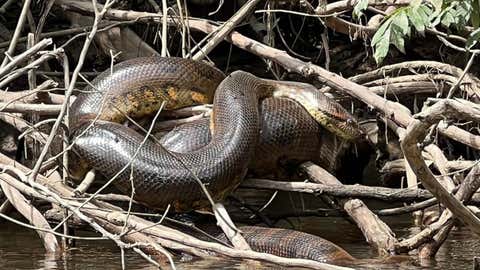Scientists Find Anaconda Species While Filming Documentary in Amazon

Northern green anaconda on a riverbank.
(Image credits: Bryan Fry/The University of Queensland)
Ever found a new animal species while at work? That’s pretty much what happened to a team of scientists venturing into the Amazon. Their plan was to film a documentary on oil drilling with National Geographic for the upcoming Disney+ series Pole to Pole with Will Smith. Little did they know, their expedition would take a breathtaking turn, unveiling a hidden marvel of nature—a previously undocumented species of giant anaconda!
Professor Bryan Fry from The University of Queensland, a National Geographic Explorer serving as the expedition’s scientific leader, led the team in capturing and studying several specimens of the newly named northern green anaconda (Eunectes akayima). These giants were found in the Bameno region of Baihuaeri Waorani Territory in the Ecuadorian Amazon.
“Our team received a rare invitation from the Waorani people to explore the region and collect samples from a population of anacondas, rumoured to be the largest in existence,” Professor Fry revealed.
The indigenous hunters guided them into the jungle on a 10-day expedition to search for these snakes, which they consider sacred. Together, they navigated canoes down the river system and were fortunate enough to encounter several anacondas lurking in the shallows, awaiting their prey.
“The size of these magnificent creatures was incredible—one female anaconda we encountered measured an astounding 6.3 metres long! There are anecdotal reports from the Waorani people of other anacondas in the area measuring more than 7.5 metres long and weighing around 500 kilograms,” Fry added.
Professor Fry disclosed that the northern green anaconda species diverged from the commonly-known southern green anaconda nearly 10 million years ago, with a genetic difference of 5.5%. This disparity is noteworthy—for comparison, humans differ from chimpanzees by only about 2%.
Describing the journey as a genuine cross-cultural endeavour, Fry emphasised the significance of their collaboration with the Waorani community. Consequently, the Waorani collaborators have been acknowledged as co-authors of the research paper.
Meanwhile, these rare anacondas, along with other species sharing this remote Amazonian ecosystem, face significant challenges such as deforestation, habitat degradation from land fragmentation, forest fires, drought, and climate change. Therefore, the urgency for further research on these endangered species and ecosystems cannot be overstated.
The research paper is published in MDPI Diversity and can be accessed here.
**
For weather, science, and COVID-19 updates on the go, download The Weather Channel App (on Android and iOS store). It’s free!
